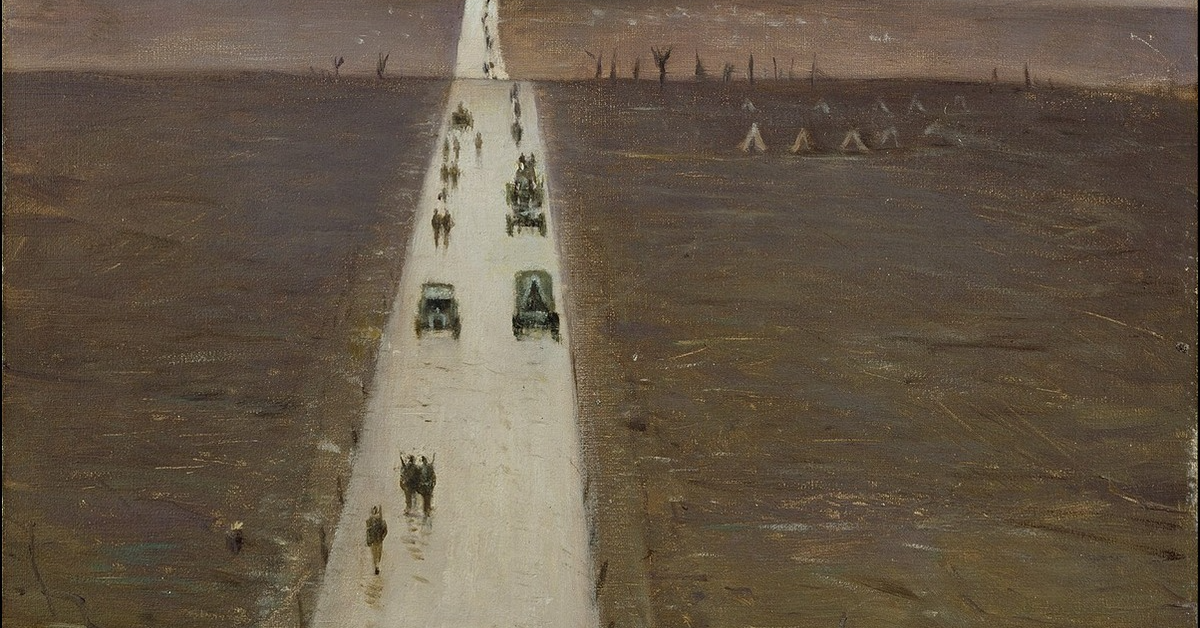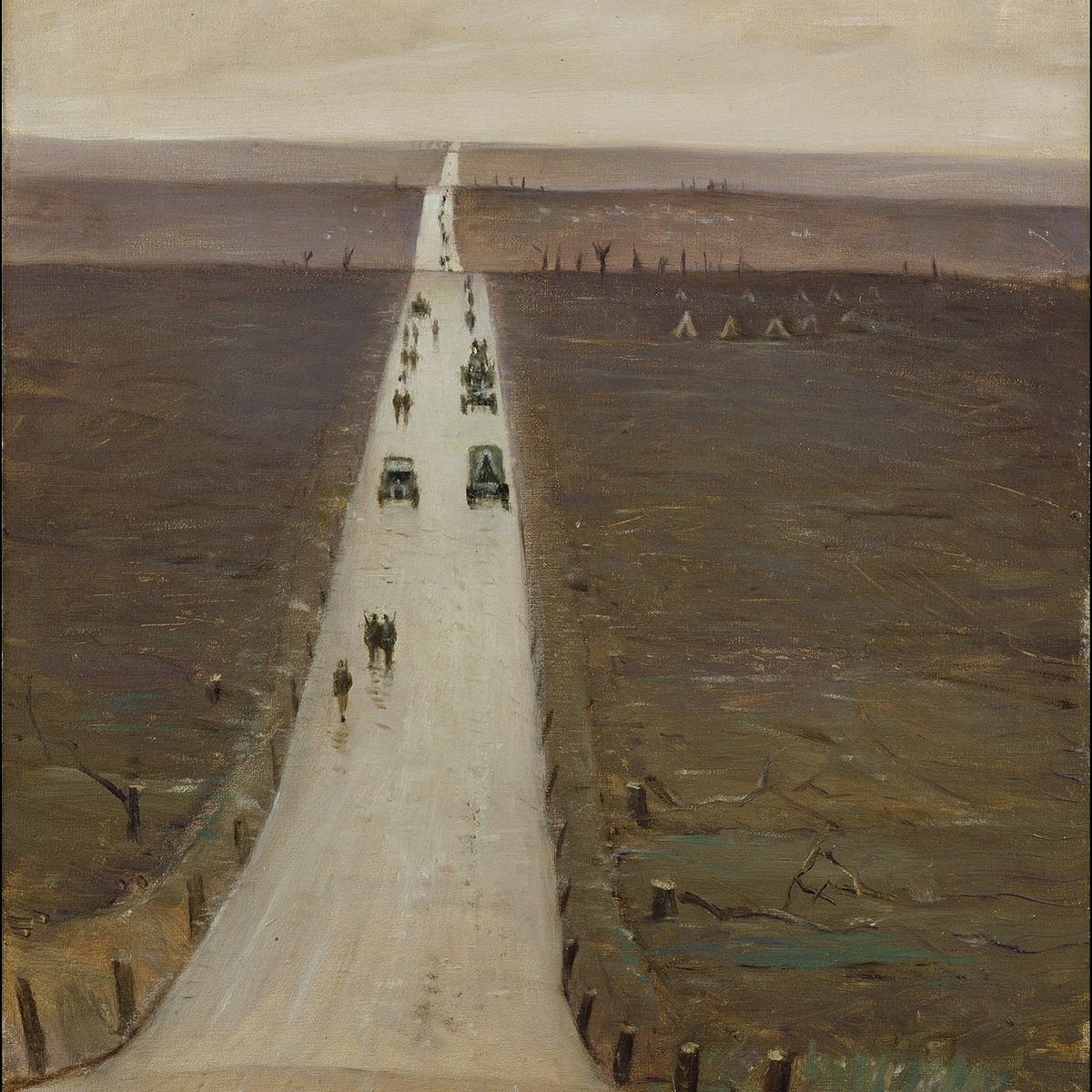Fiona MacCarthy in William Morris: A Life for Our Time, describes Morris recalling nostalgically the poplar meadows and little villages of the Somme as well as the long straight roads of Picardy seemingly stretching into eternity: “Those long straight roads of Northern France”, she wrote, “remained in Morris’s mind as they would remain in the memories of the English veterans of the First World War.”
Elaine and I recently traveled many of these same roads, which neither Morris nor the British troops would have difficulty in recognizing today, as the landscape is little changed, apart from the implantation of the now ubiquitous wind farms, and the chilling number of cemeteries and memorials to the British and Commonwealth war dead. As we drove through this wide open flat landscape two images kept coming into my mind; Harry Lauder’s poignant ‘Keep right on to the end of the road‘, adopted by the British troops as one of their popular marching songs, and C.R.W. Nevinson’s haunting (and daunting) 1918 lithograph The Road from Arras to Bapaume. It was, of course, the memorials that drew us to Picardy and Flanders, but given the pounding this area of Northern France suffered during two World Wars it was surprising to find that anything of antiquity still endures.
Following our stay in the lush Norman countryside our base for the last two days will be Arras, a remarkable city with two great cobbled squares – the Grand Place and the Place des Heros. The architecture of which – as indeed the cuisine – reminds us that we are now unmistakably in old Flanders, its towns and cities only ceded to France in the early eighteenth century. In June we will have unrestricted access to these squares and will be able to walk freely around, a pleasure denied to us because, true to their roots, the locals were busy setting up the round-a-bouts, hurdey-gurdies, and other trappings of a typical Flemish Christmas Fair.
In 1917, well before the end of the war, the British Government had the foresight to set up the Imperial War Graves Commission under the chairmanship of Sir Frederick Kenyon, paleontologist, biblical scholar and Director of the British Museum. In January 1918, Kenyon published his prescient and authoritative report: ‘War Graves: How the Cemeteries Abroad Will be Designed’, which established the architectural and administrative framework for the design of all the British and Commonwealth cemeteries.
Lutyens, Herbert Baker and Reginald Blomfield were appointed by the Commission as the Principal Architects, and Arthur Hill, from the Royal Botanic Gardens, Kew, was appointed to devise the simple, sustainable and dignified planting of trees and shrubs. Despite these guidelines the architects’ job was no easy one as the combatants, to be memorialized side by side, were of all religions and none; their gravestones simply carved with their names in the Roman typeface specially designed by Macdonald Gill, brother of the better known Eric Gill, and along with their regimental badges. Lutyens designed the altar-like, but non-denominational, War Stone inscribed simply ‘Their Name Liveth For Evermore’, which was placed at the heart of all the cemeteries, often in conjunction with Blomfield’s equally dignified non-denominational cross. Between them they give an overall unity to otherwise diverse designs.
In my last blog I described Lutyens’s late nineteenth-century domestic architecture at Varengeville-sur-Mer, and his inventiveness and playfulness with architectural forms, especially the triple-butterfly plan for le Maison des Communes. Here on the battle fields of the Somme, faced with the realities of mass slaughter, a hardness entered into his architectural vocabulary. His delight in the effect of contrasting architectural forms is still evident, but coupled now with a sense of grimness: his playfulness overlayed by a rigid austerity, emphasized further, in a number of instances, by the close proximity of serried ranks of identical gravestones.
Our June tour is devised primarily as an Arts and Crafts tour in the footsteps of William Morris and Lutyens, rather than a tour of the many cemeteries and memorials on the Western Front, so for these two days we have been ruthless in selecting those we will visit. These will include the four grandest – Lutyens’s Memorial to the Missing at Thiepval and his Australian Memorial at Villers Bretonneux, Herbert Baker’s Delville Wood (also Australian) and Walter Allward’s Canadian War Memorial at Vimy Ridge.
We will also visit Lutyens’s Daours Communal Cemetery Extension, which, in its modesty and human scale, reflects more closely his earlier Arts and Crafts ideals, which are also evident in Charles Holden’s nearby Corbie Military Cemetery. Herbert Baker, architect of imperial buildings in South Africa and Lutyens’s nemesis at New Delhi, exemplifies in his work that period progression from Arts and Crafts to stripped-down classicism and in addition to Delville Wood, we will visit his Indian Memorial at Neuve Chapelle which, in the diversity of its decoration, shows the eclecticism of the Arts and Crafts Movement. Walter Allward’s dramatic Canadian Memorial at Vimy Ridge is all together more starkly modernist, rising out of, and dominating, the landscape like some great pharaohnic obelisk. We were lucky enough to see it in the cold clear light of a setting November sun and, although the June days will be long, we will save this for the final experience on our last evening.


